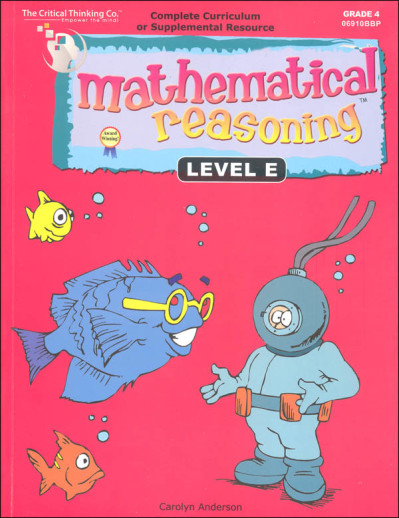We use cookies to make your experience better. To comply with the new e-Privacy directive, we need to ask for your consent to set the cookies. Learn more.
Mathematical Reasoning Level E (Gr. 4)
CONTENTS
- Addends
- Addition
- Age
- Analyze Data
- Angles
- Area
- Bar Graph
- Calendar
- Capacity
- Characteristics
- Circle Graphs
- Coins
- Congruence
- Coordinates
- Count
- Data Analysis
- Data Collection
- Decimals
- Division
- Equations
- Equivalence
- Estimate
- Fractions
- Graphs
- Inequalities
- Language
- Length
- Match
- Mean
- Median
- Mode
- Money
- Multiplication
- Negative Numbers
- Number Lines
- Odd/Even
- Order
- Parallel
- Patterns
- Perimeter
- Perpendicular
- Place Value
- Prediction
- Prime/composite
- Probability
- Properties
- Real World Problems
- Reflection/Translation/Rotation
- Regrouping
- Rounding
- Rulers
- Shapes
- Subtraction
- Survey
- Symmetry
- Tables
- Temperature
- Time
- Variables
- Weight
At such an early age, mathematical reasoning begins with simple activities such as distinguishing between even or odd amounts and learning the ordinal numbers. The Mathematical Reading series is correlated to the NCTM standards and accordingly incorporates topics such as patterns, number concepts/number lines, graphs, fractions, probability, geometry, and problem solving, as well as basic operations. The full color activity sheets should especially appeal to the younger student. Not only are the illustrations eye-catching, but they do an excellent job of demonstrating mathematical representations and relationships. Although manipulatives are not required, a link to a virtual manipulative website is provided in case additional concrete level reinforcement is needed. A wide variety of exercises and activities are utilized to keep your child both interested and motivated.
Beginning 1 focuses on numbers 1-5 while Beginning 2 focuses on 0-10, and they are intended for use with 3 and 4 year olds. The concepts are presented in a spiral fashion, so students will see the concept repeated at different intervals throughout the book. In most cases, children who finish these first two books should be ready to tackle kindergarten math.
Books A through G are for grades K-6 and can be used as a core math curriculum. These books can also be used as a critical thinking supplement to any math program. These books incorporate the same spiral approach found in the Beginning books.
| Product Format: | Paperback Book |
|---|---|
| Grade: | 4 |
| Brand: | Critical Thinking Company |
| ISBN: | 9781601446459 |
| Length in Inches: | 11 |
| Width in Inches: | 8.5 |
| Height in Inches: | 1 |
| Weight in Pounds: | 2.6 |


Looking for analysis and application math as a supplement
I've searched high and low for a math workbook that doesn't make my daughter cry and the Mathematical Reasoning series fits the bill! This series approaches math in a logical and systematic way…
My kids have enjoyed this series.
We have been using this math program for several years. We all enjoy how the book rotates through different types of math practice.